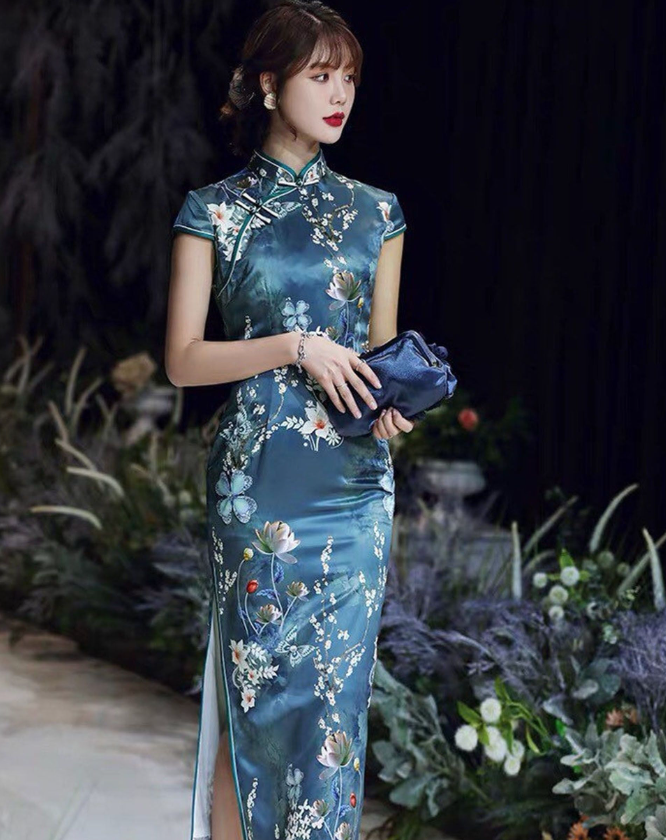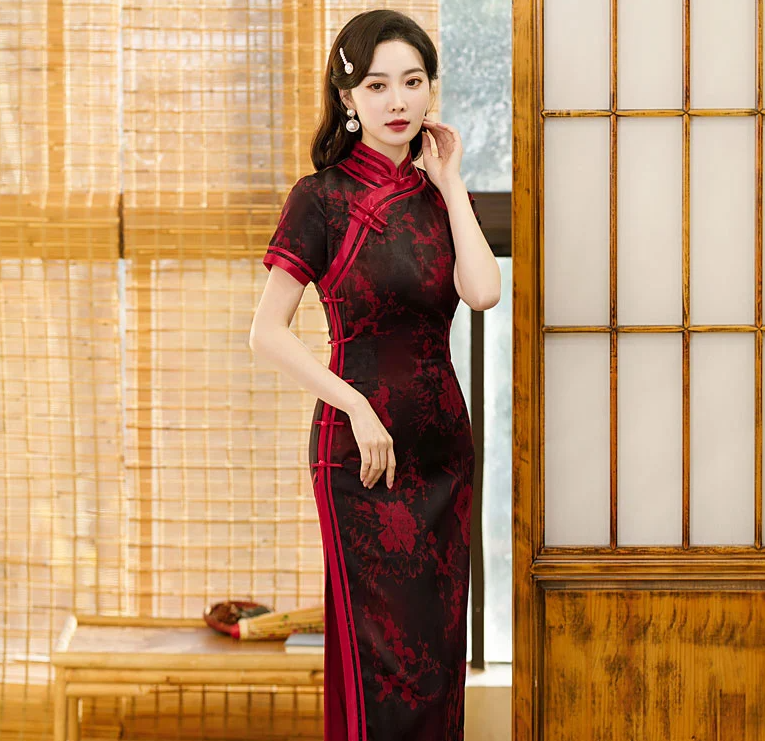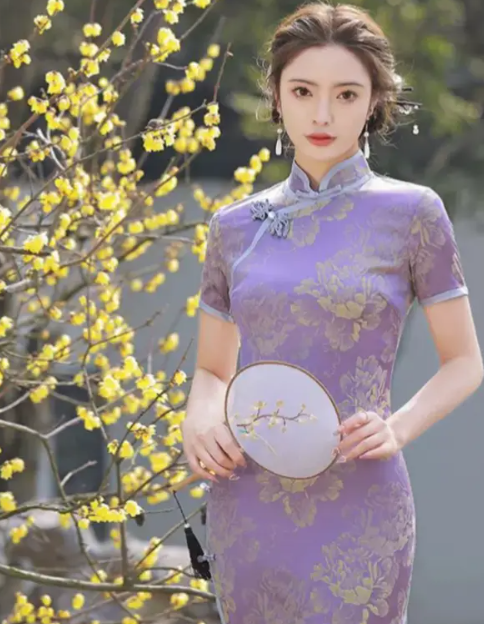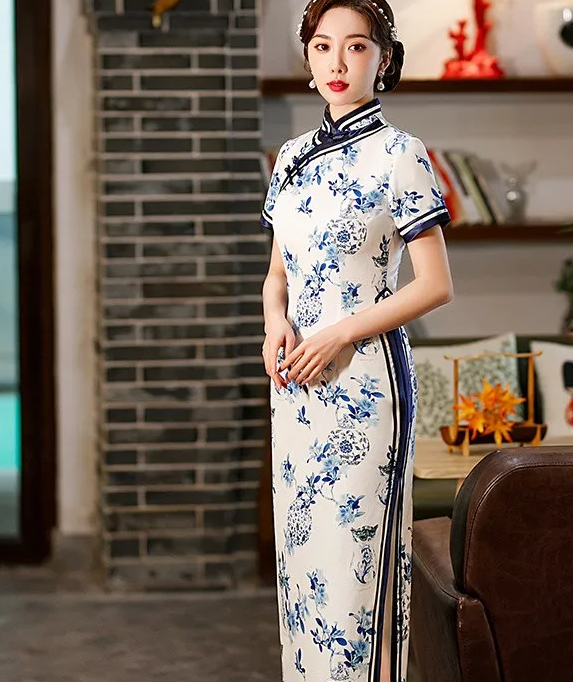Select a cheongsam based on occasion, fabric, fit, color, pattern, and complementary accessories.
Understanding the Different Styles
Cheongsam, often known as ‘Qipao’ in Mandarin, has undergone several evolutionary stages, adapting to the changing fashion trends and societal norms. From the traditional Manchu origins to the current urban fashionistas, the dress embodies both cultural significance and modern aesthetic appeal.

Traditional vs. Modern cheongsam designs
Traditional Cheongsam: Originating from the Manchu ethnic group during the Qing Dynasty, the traditional design is characterized by its modesty. It generally has a high neckline, loose fit, and is often adorned with intricate embroidery or motifs representing good luck, prosperity, or longevity.
Modern Cheongsam: With the cultural shifts and globalization, the cheongsam has evolved into a more form-fitting design. The modern versions can have side slits, a lower neckline, and are made in a variety of fabrics ranging from silk to synthetic materials. The designs can range from simple and elegant to those embellished with beads, sequins, or modern prints.
Length variations: Short, knee-length, and long
Short Cheongsam: Typically ending above the knee, short cheongsams are suitable for more casual occasions or warmer climates. They offer more mobility and are often chosen for their youthful and playful vibes.
Knee-length Cheongsam: This length strikes a balance between tradition and modernity. Offering a silhouette that’s universally flattering, the knee-length design is versatile, suitable for both semi-formal events and casual outings.
Long Cheongsam: Exuding a sense of elegance and formality, the full-length cheongsam is often reserved for special occasions like weddings or formal banquets. Traditionally, this length was the standard, representing modesty and grace.
Sleeve styles: Sleeveless, short, elbow-length, and long
Sleeveless Cheongsam: Popular among the younger generation and in hotter climates, the sleeveless design accentuates the arms and is usually paired with modern fabrics or daring patterns.
Short Sleeves: Providing a balance between modernity and tradition, short sleeves are versatile and can be worn for a multitude of events, from business meetings to casual gatherings.
Elbow-length Sleeves: An elegant choice that offers a bit more coverage than short sleeves, elbow-length sleeves are reminiscent of the mid-20th-century styles when the cheongsam gained international acclaim.
Long Sleeves: The epitome of traditional design, long sleeves often feature intricate details like Chinese knot buttons or embroidered cuffs. They’re ideal for formal occasions and cooler climates.
Choosing the Right Fabric
The fabric choice for a cheongsam can drastically impact its appearance, feel, and durability. Different fabrics offer varied textures, sheens, and drapes, all of which contribute to the overall aesthetics of the dress. In addition, the material can influence the cost, lifespan, and quality of the cheongsam.
Common materials used: Silk, satin, brocade, and more
Silk: Revered as one of the most luxurious materials, silk offers a natural sheen and a smooth texture. Its breathable nature makes it comfortable to wear, especially in warmer climates. Quality silk cheongsams can be relatively expensive, with prices ranging from $100 to over $1000, depending on craftsmanship and design.
Satin: A glossy fabric made from both natural and synthetic fibers, satin offers a sheen similar to silk but at a more affordable price point. A typical satin cheongsam might range from $50 to $500.
Brocade: A rich fabric woven with an intricate design, brocade is often associated with traditional cheongsams. Its heavy texture makes it suitable for formal occasions. Brocade cheongsams can be priced anywhere between $80 to $800, depending on the intricacy of the pattern and the quality of material.
Others: Other materials like velvet, cotton, and synthetic blends are also popular. Velvet exudes luxury and warmth, making it apt for colder climates, while cotton offers breathability and comfort, especially for daily wear.
How fabric affects the drape and fit
Silk and Satin: These fabrics are known for their fluid drape, closely hugging the contours of the body. The result is a form-fitting cheongsam that accentuates the figure, suitable for both traditional and modern designs.
Brocade and Velvet: Due to their thicker composition, these materials offer a more structured fit. They hold their shape and provide a grandeur that’s unmatched, making them a favorite for grand occasions.
Importance of fabric in traditional vs. modern designs
Traditional Designs: Materials like silk and brocade are staples in traditional designs. Their natural sheen and patterns resonate with the historical essence of the cheongsam. Traditional designs might prioritize longevity and heirloom quality, so investing in high-quality materials is common.
Modern Designs: Modern cheongsams have embraced a wider variety of materials, including synthetic blends. These materials offer durability, ease of care, and affordability. Modern designs often prioritize versatility and adaptability, leading to the selection of fabrics that cater to varied occasions, from casual outings to formal events.
Finding the Perfect Fit
Achieving the right fit in a cheongsam is crucial. A well-fitted cheongsam flatters the wearer’s figure, showcasing the dress’s intricate details, while ensuring comfort and ease of movement. Considering the close-fitting nature of the garment, even slight discrepancies in measurements can impact the overall appearance.
Measurements to consider: Bust, waist, hips, and length
Bust: Measure around the fullest part of your chest, ensuring the tape is snug but not tight. This is the pivotal measurement, especially for cheongsams with a fitted bodice.
Waist: Locate the narrowest part of your torso, typically an inch or two above the navel. This measurement helps define the silhouette, crucial for a dress that accentuates curves.
Hips: Measure around the widest part of your lower body, ensuring the tape encompasses the fullest part of your buttocks. Given the form-fitting nature of the cheongsam, especially around the hips and thighs, this measurement ensures a flattering fit.
Length: Depending on personal preference and the style of cheongsam (short, knee-length, or long), measure from the top of your shoulder to the desired endpoint. This determines how the cheongsam will fall on your body, influencing both aesthetics and mobility.
Importance of tailored fitting in cheongsam
Tailored fitting is the heart and soul of a perfect cheongsam. Historically, cheongsams were custom-made, ensuring a snug fit that complemented the wearer’s figure. While off-the-rack options are available today, a tailored fit is still unmatched. A custom-fitted cheongsam can cost anywhere from $150 to over $2000, depending on the fabric and intricacy of design. This investment ensures that the dress sits flawlessly, enhancing comfort and exuding elegance.

Adjustments and customizations for a comfortable fit
Bodice Adjustments: Some individuals might require darts or tucks, especially around the bust area, to ensure the fabric doesn’t gape.
Side Slits: Modern cheongsams often come with side slits for added mobility. Depending on personal preference, the height and length of these slits can be adjusted.
Collar Modifications: The traditional Mandarin collar might feel restrictive to some. It’s possible to adjust the height or choose a different style altogether for a more relaxed fit.
Additional Elements: Elements like additional lining, padding, or even pockets can be introduced for functionality and comfort.
Selecting the Appropriate Color and Pattern
Colors and patterns play a pivotal role in the aesthetics of a cheongsam. Beyond mere appearance, they carry cultural significance, express personal style, and set the tone for the occasion. While there’s a broad spectrum of colors and patterns to choose from, understanding their implications can help in making an informed decision.
Traditional colors and their meanings
Red: A dominant color in Chinese culture, red symbolizes luck, happiness, and prosperity. It’s a popular choice for celebratory events like weddings or Chinese New Year.
Gold: Representing wealth, grandeur, and luxury, gold often accompanies red, especially in festive or ceremonial attire.
Green: Associated with growth, harmony, and freshness. Historically, it also hinted at social status.
Black: While often associated with mourning in some cultures, in the context of cheongsam, black can represent sophistication and elegance, especially when adorned with contrasting patterns.
White: Traditionally, white was linked to mourning. However, in modern times, it signifies purity, simplicity, and elegance, especially in summer designs.
Blue: Symbolic of immortality and advancement, blue is a serene and versatile choice.
Modern color trends in cheongsam design
While traditional colors remain popular, contemporary cheongsam designs embrace a broader palette, influenced by global fashion trends. Pastels like lavender, peach, and mint green are gaining popularity for their subtle elegance. Neutral shades such as beige, taupe, and gray are lauded for their versatility and understated charm. Ombre cheongsams, transitioning from one color shade to another, are also a trendsetting choice.
Choosing patterns: Floral, geometric, and symbolic motifs
Floral Patterns: Evoking nature’s beauty, floral patterns, whether it’s peonies, chrysanthemums, or orchids, carry various symbolic meanings. For instance, the peony symbolizes wealth and honor.
Geometric Designs: A nod to modern aesthetics, geometric patterns like checks, stripes, or abstract shapes offer a contemporary twist to the traditional dress.
Symbolic Motifs: Dragons, phoenixes, and bamboos are among the traditional symbols often embroidered or printed on cheongsams. The dragon, for instance, signifies power, strength, and good luck.

Accessorizing the Cheongsam
The cheongsam, in its elegance, offers a wonderful backdrop for various accessories. Just as with any ensemble, the right accessories can elevate the look, adding a touch of glamour, tradition, or contemporary flair. Here’s a deep dive into accessorizing this iconic attire.
Traditional accessories: Jade jewelry, hairpins, and more
Jade Jewelry: Revered in Chinese culture for its beauty and symbolism, jade is a go-to accessory for cheongsam. Whether it’s a jade bangle, pendant, or earrings, these pieces signify purity, protection, and grace. Price can range from $50 for simpler pieces to thousands of dollars for intricate designs.
Hairpins: Historically, hairpins made of silver, gold, or adorned with pearls were essential to a woman’s attire. They not only held intricate hairstyles in place but also symbolized the wearer’s social status.
Fans: Hand-held fans, often made of silk and bamboo, added an element of grace and mystique to the overall attire. They were functional, especially in warmer months, and served as a symbol of gentility.
Modern accessories that complement the outfit
Statement Necklaces: Modern cheongsams, especially those with simpler patterns, can be paired with bold necklaces. Whether it’s a chunky choker or a long pendant necklace, they can add a pop of contemporary style.
Earrings: Drop earrings, studs, or hoops, depending on the dress’s neckline and the wearer’s hairstyle, can bring attention to the face and add a touch of sparkle.
Belts: A thin belt, especially with cheongsams that have a looser fit, can accentuate the waistline, adding both function and fashion.
Handbags: Clutches or small shoulder bags, in complementary colors, can be a practical and stylish addition. The choice of bag can vary based on the event – a shimmering clutch for a gala or a leather crossbody for a casual outing.
Shoe pairing: Traditional vs. contemporary choices
Traditional Shoes: Historically, embroidered silk shoes or slippers, often in colors matching the dress, were the go-to choice.
Contemporary Choices: Today, the cheongsam pairs wonderfully with a range of footwear. Stilettos or pumps, especially for formal events, elongate the legs and enhance the dress’s elegance. For a more relaxed look, ballet flats or even sleek sneakers can be a chic choice. Remember, the shoe’s color and style should complement the dress. For instance, a red cheongsam might pair well with gold or nude heels.
Wearing Cheongsam for Different Occasions
The versatility of the cheongsam is evident in its adaptability to various occasions. From regal ceremonies to casual gatherings, the dress’s elegance, paired with the right accessories and design choices, allows it to fit seamlessly. Here’s a guide to donning the cheongsam for different events.

Formal events: Weddings, banquets, and ceremonies
Weddings: The cheongsam has made a resurgence in modern weddings, either as the primary dress for brides or as a change of attire for the reception. They often come with a higher price tag, ranging from $200 to well over $1000, depending on the quality of material and craftsmanship.
Banquets: For lavish dinners or formal gatherings, a silk or satin cheongsam, possibly with modest embellishments, makes an elegant statement. Accessorizing with jade jewelry or diamond studs can enhance its sophistication.
Ceremonies: Be it a university graduation or a significant anniversary, a well-fitted cheongsam in muted colors or with delicate patterns can be both respectful and stylish. Paired with mid-heel shoes and a matching clutch, it’s a picture of refined grace.
Casual wear and modern adaptations
Short Cheongsams: Modern fashion has seen the rise of shorter cheongsams, ending at the knee or even higher. These are excellent for casual outings or summer brunches. Paired with ballet flats or sandals, they offer a blend of tradition and modernity.
Cheongsam Tops: For those who adore the collar and design but seek a more relaxed vibe, cheongsam-inspired blouses or shirts can be paired with jeans or skirts.
Fabric Choices: Cotton or linen cheongsams are breathable and apt for casual wear. They might come at a more affordable price range, starting from $40 onwards.
Festive occasions: Chinese New Year, Mid-Autumn Festival, and more
Chinese New Year: This festivity often sees families dressed in their finest. A new cheongsam, typically in red, is worn to symbolize a fresh start. Bright, vibrant patterns, often with symbolic motifs like the dragon or phoenix, are popular.
Mid-Autumn Festival: Celebrating the moon’s beauty, this festival might see women in cheongsams with moon or rabbit patterns, given the Moon Rabbit folklore. Blue or silver tones can be especially apt, reflecting the moonlit theme.
Other Festivals: Depending on the region and specific celebration, there might be specific colors or patterns associated with the festival. However, the unifying theme is always one of joy, reverence, and tradition.